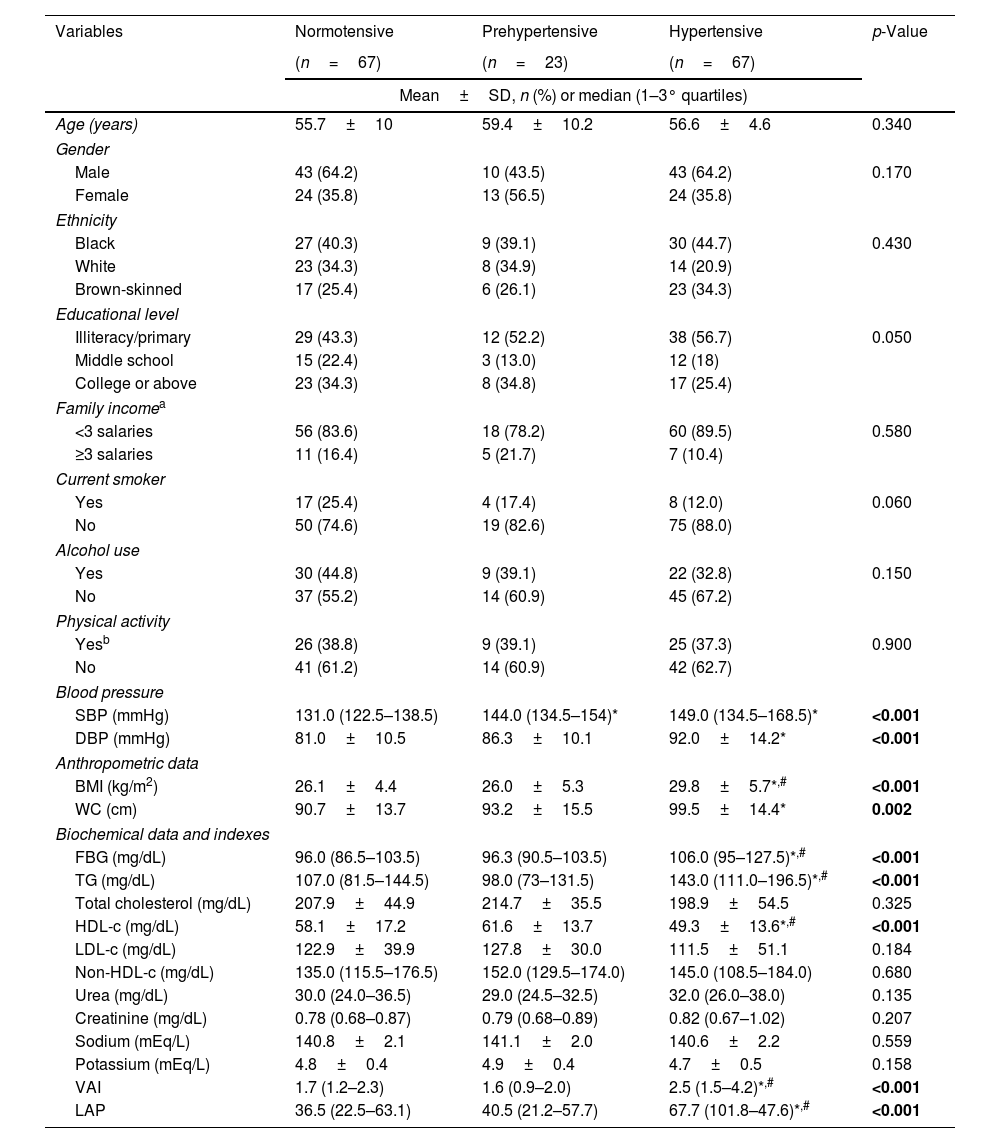Although some studies have reported the association between uric acid (UA) and hypertension, evidence on prehypertension is still lacking. Therefore, the objective of this study was to determine the levels of UA and other cardiovascular markers among prehypertensive and hypertensive patients and assess their risk for developing arterial hypertension.
Methods157 individuals were recruited: 67 normotensive, 23 pre-hypertensive and 67 hypertensive. Blood samples were collected to measure biochemical parameters and anthropometric measurements and blood pressure were evaluated. We calculated the product of lipid accumulation and the visceral adiposity index to assess cardiovascular risk.
ResultsOur data showed an increase in UA levels in normotensives (4.9±1.3mg/dL), prehypertensives (5.2±1.3mg/dL) and hypertensives (5.9±1.6mg/dL) (p=0.004). We found a higher frequency of hyperuricemia in the hypertensive group (34.3%) than in the normotensive group (13.4%, p<0.05). Hypertensive volunteers had lower levels of HDL-C (p=0.004 and p=0.003) and higher body mass indexes (p<0.001 and p=0.007), glucose (p<0.001 and p=0.033), triglycerides (p=0.001 and p=0.005), visceral adiposity index (p<0.001 and p=0.002) and lipid accumulation product (p<0.001 and p=0.007) than normotensive and prehypertensive participants. We also observed that individuals with UA≥6.2mg/dL had an increased risk of hypertension of 4.77 (p=0.003) compared to individuals with levels≤4.3mg/dL.
ConclusionOur results showed that UA is associated with increased blood pressure and unfavorable changes in anthropometric and biochemical parameters, which represent risk factors for hypertension and cardiovascular diseases.
Aunque algunos estudios han reportado la asociación entre ácido úrico (AU) e hipertensión, aún falta evidencia sobre la prehipertensión. Por tanto, el objetivo de este estudio fue determinar los niveles de AU y otros marcadores cardiovasculares entre pacientes prehipertensos e hipertensos, y evaluar su riesgo de desarrollar hipertensión arterial.
MétodosSe reclutaron 157 individuos: 67 normotensos, 23 prehipertensos y 67 hipertensos. Se recolectaron muestras de sangre para medir parámetros bioquímicos y se evaluaron medidas antropométricas y presión arterial. Calculamos el producto de la acumulación de lípidos y el índice de adiposidad visceral para evaluar el riesgo cardiovascular.
ResultadosNuestros datos mostraron un aumento en los niveles de AU en normotensos (4,9±1,3mg/dl), prehipertensos (5,2±1,3mg/dl) e hipertensos (5,9±1,6mg/dl) (p=0,004). Encontramos una mayor frecuencia de hiperuricemia en el grupo de hipertensos (34,3%) que en el grupo de normotensos (13,4%; p<0,05). Los voluntarios hipertensos presentaron niveles más bajos de HDL-c (p=0,004 y p=0,003) y mayores índices de masa corporal (p<0,001 y p=0,007), glucosa (p<0,001 y p=0,033), triglicéridos (p=0,001 y p=0,005), índice de adiposidad visceral (p<0,001 y p=0,002) y producto de acumulación de lípidos (p<0,001 y p=0,007) que los participantes normotensos y prehipertensos. También observamos que los individuos con AU≥6,2mg/dl tenían un mayor riesgo de hipertensión de 4,77 (p=0,003) en comparación con los individuos con niveles ≤4,3mg/dl.
ConclusiónNuestros resultados mostraron que elAU se asocia con el aumento de la presión arterial y los cambios desfavorables en parámetros antropométricos y bioquímicos, que representan factores de riesgo para hipertensión y enfermedades cardiovasculares.









